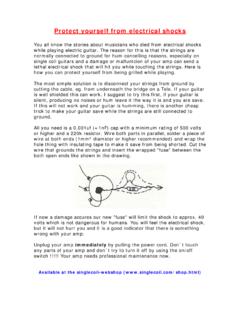Transcription of Eye on Safety - berkleyag.com
1 March 2018 Copyright J. J. Keller & Associates, Inc. Volume 8 Issue 3 Inside this issue:Berkley Agribusiness is here to partner with our customers to assist them with their insurance hazards and risk of commercial agribusiness are unique to that type of business. Risk control that is experienced and knowledgeable in commercial agribusiness can assist you in controlling those hazards and risk. Berkley Agribusiness experienced and specialized claims personnel will provide a customer-first approach to handling your and coating have unique hazards ..1 Safety focus: Safe work practices around electricity ..3 Avoiding the flu ..4 Dipping and coating have unique hazardsPainting, plating, stripping, and cleaning are essential operations in many workplaces.
2 Make sure you are prepared for these jobs .What are dipping and coating operations?Dipping and coating operations involve the use of chemicals . OSHA addresses the hazards of dipping and coating operations in the rules at 1910 .122 126 . These standards are designed to protect employees from toxic exposures, fire, and other hazards . The OSHA standards apply when you use a dip tank containing a liquid other than water . It applies when you use the liquid in the tank or its vapor to: Clean an object; Coat an object; Alter the surface of an object; or Change the character of an object .The rule also applies to draining or drying operations . It does not apply when the operation uses a molten material.
3 Some examples of operations that use dip tanks include: Paint dipping; Electroplating; Pickling; Quenching; Tanning; Degreasing; Stripping; Cleaning; and Roll coating, flow coating, and curtain coating .The hazardsDuring dipping and coating operations, parts or other items are typically put into a tank for treatment . As items enter and leave the liquids in the tanks, there is a potential for splashing, dripping, or spattering . The liquids may present health hazards . Sometimes liquids in a tank are heated to high temperatures . Handling items during the job may cause splashes . You may be at risk for chemical or thermal burns . You can learn about the hazards by reading the chemical s Safety data sheet (SDS).
4 Take precautions to protect yourself from direct contact and from the inhalation of harmful vapors . (continued on page 2)Eye on Safety2 Copyright J . J . Keller & Associates, Inc . March 2018 Another hazard is the slipping/falling hazard that comes from working in an area with the potential for wet floors . Mats, grating, and slip resistant footwear help reduce the risk of injury .When flammable liquids are used, there s the potential for fires . Fire extinguishing systems and other specialized equipment must be installed for fire protection . Portable fire extinguishers must be available .PPE and ventilationPersonal protective equipment (PPE), covers, and ventilation equipment can help you avoid hazards.
5 Eye and face protection is needed when you are exposed to chemical splash hazards . Goggles fit close to the eyes and provide the best protection from splashes . A face shield worn over eye protection provides additional protection for the face .Rubber gloves protect the hands from hazardous liquids and vapors . Rubber gloves are selected for their chemical resistance to the liquid used in the process . If you need to reach into the liquid, make sure the gloves are long enough to keep the liquid from getting into the glove . Foot protection, including the use of rubber boots, may be required .You might also need to wear aprons, coveralls, or other types of chemical-resistant clothing.
6 Ventilation systems help remove harmful vapors from the work area . However, back-up procedures, including the use of respirators, must be in place in case the ventilation system fails . Atmosphere-supplying respirators are required if there s an oxygen-deficient atmosphere (oxygen levels are below 19 .5 percent) .All types of PPE have some limitations that you should be aware of . Use the right type of PPE for the job, and make sure it s in good condition . Damaged PPE doesn t give you the same amount of protection .Emergency ProceduresYou must know the first aid procedures appropriate for the hazards to which you are exposed . If you re expected to respond to emergencies such as spills or fires, you ll need specialized equipment and training.
7 Everyone should know how to evacuate the area and call for emergency responders in case of an emergency .To help prevent fires, keep the area clean . Contaminated rags and other materials must be placed in approved waste cans immediately after use, and the contents of the waste cans are to be properly disposed of at the end of each shift . Don t smoke in the tank s vapor area .Maintenance operations involving entry into a tankYou may need to enter the dip tank for cleaning, inspection, or repair jobs . Even when the liquid is drained from the tank, the entry operations can still be hazardous .When a dip tank meets the definition of a permit-required confined space (see 1910.)
8 146), all of the provisions of an entry permit must be in place before anyone can go into the tank . Employees on the entry team must have the proper training .An example of a dipping and coating accident from OSHA A maintenance worker at a company in Nebraska jumped into a tank containing 18,000 gallons of potassium hydroxide . The tank was part of a 13-tank dip tank system used in the manufacture of heavy farm machinery .An unguarded, elevated catwalk ran between two of the 18,000-gallon tanks . The tanks were serviced by an overhead crane that moved parts in and out of the tanks . As the crane traversed the catwalk in its lowered position, there were only a few inches of clearance between the crane mechanism and the catwalk.
9 The worker had to make an adjustment to a spray nozzle on one of the tanks . He thought he had enough time to run out on the catwalk and make the repair before the crane traversed the catwalk again . While making the repair, he turned around and saw that the crane was upon him . He had only a split second to decide what to do . He later said that he felt his only recourse was to jump into the tank in order to avoid being struck and pinned by the crane . He survived, but was hospitalized with chemical burns .Dipping and coating have unique hazards (continued from page 1)March 2018 Copyright J . J . Keller & Associates, Inc . 3 Safety focus: Safe work practices around electricityElectricity is such an integral part of our lives at home and in the workplace that we tend to take its power for granted.
10 But a sobering fact is that hundreds of workers are electrocuted each year . Electrical accidents in the workplace can, for the most part, be avoided if you use safe electrical equipment and work practices .What are the hazards of electricity?The primary hazards of electricity and its use are shock, burns, arc-blast, explosions, and fire .Electric currents travel in closed circuits through some kind of conducting material . You get a shock when some part of your body becomes part of an electric circuit . High-voltage shocks can cause serious injury (especially burns) or death . The severity of the shock a person receives depends on the amount and the path of the electric current flowing through the body, as well as how much time elapses while the body is part of the electric circuit.



